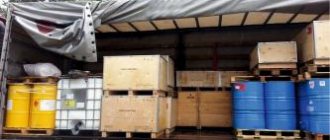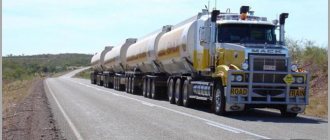Remember the famous thesis expressed by Ostap Bender: “A car is not a luxury, but a means of transportation”? Nowadays it can be supplemented with the words “people and cargo”.
While most motorists have no questions about the rules for transporting passengers, not everyone is familiar with the nuances associated with transporting goods. A whole section is devoted to this issue in the Traffic Rules.
Traffic rules requirements
In the traffic rules, section 23 is devoted to the transportation of goods, consisting of five points, in which the legislator has provided for all possible situations that arise during their transportation by road.
23.1 deals with permissible values for cargo mass. 23.2 requires the driver to control its placement and fastening.
Clause 23.3 of the traffic rules clearly states when the carriage of cargo is allowed and has five paragraphs, of which it is worth mentioning something quite unusual for modern drivers that many drivers forget: the placement of cargo should not interfere with the perception of hand signals.
Permissible dimensions of cargo for transportation by road
What is considered a large-sized cargo, the transportation of which does not require special permits, but has strictly defined transportation rules specified in the traffic rules?
By lenght
If the load protrudes beyond the front and rear dimensions of the vehicle by more than 1 m, but not more than 2 m. It should be noted here that despite the presence of the letter “and”, you can read “or”. Let’s say the load is extended more than a meter just beyond the rear side of the car, but not in front, it is already becoming large.
Width
It also indicates how much the load can protrude across the width of the car - no more than 40cm.
ATTENTION. Unlike the first case, where the length of the protruding part should be measured from the extreme point of the car, here the measurement is made from the edge of the rear marker light, which means that it will actually protrude slightly less than the prescribed 40cm, since the specified lamp is always located somewhat deeper than the extreme side point car.
If, after measurements, at least one parameter exceeds the above standards, it should be o, and in the dark or in case of insufficient visibility, also with flashlights or reflectors: white in front and red in back.
By height
Despite the fact that clause 23.4 of the traffic rules does not talk about the height of the load, it should be remembered that the load should not exceed four meters above the surface of the roadway (clause 23.5 of the traffic rules).
Let's consider this situation: the cargo does not protrude beyond the dimensions of the vehicle, but reaches a height of 3 meters 85 centimeters from the road surface; the “Large cargo” sign is not required.
Sometimes it happens.
Paragraph 23.5 of the traffic rules defines cargo and vehicles for transportation or passage of which will have to obtain a special permit:
Characteristics of oversized cargo
The dimensions and weight of many types of goods exceed the maximum permissible limits. Their transportation is permitted, but is regulated by traffic rules.
Proper transportation of oversized cargo
Depending on how much the characteristics of the transported items differ from the permissible ones, the conditions for allowing equipment on the roads differ. If the luggage being transported protrudes from the rear beyond the vehicle by a distance of up to one meter, and across the width of the vehicle by 0.4 m, a “Large Load” sign should be posted, white lights and reflectors installed in the front and red ones in the rear.
If the transported objects protrude from the rear of the truck by more than 2 m, and the height of the object exceeds 4 m, special rules established by the Government and the Ministry of Transport apply.
Transportation rules
On the territory of the Russian Federation, the transportation of large cargo is regulated by a number of regulations, in addition to traffic rules, this includes:
The documents are quite voluminous and informative, covering not only the topic under consideration, so we will consider them in the relevant part.
You should start with the loading rules, the basic norms of which are spelled out in sufficient detail. This includes sorting cargo by weight, namely, heavier ones are located at the bottom to maintain vehicle stability when moving; the cargo must be homogeneous and well secured. It is also prescribed to prevent gaps between loaded products, ordering them to be filled with gaskets.
Homogeneous piece cargo in the body of a vehicle must be stacked in compliance with the same number of tiers and ensuring reliable fastening of the top tier of the stack (clause 36 of Order of the Ministry of Transport No. 7 of January 15, 2014).
Here we are talking about the need to attract escort vehicles, justifying this by the increased danger when transporting large-sized cargo (clause 52 of Order of the Ministry of Transport No. 7 of January 15, 2014).
Paragraphs 53-58 of Order of the Ministry of Transport No. 7 of January 15, 2014. establish escort rules and requirements for escort vehicles. Tractors and (or) State Traffic Inspectorate vehicles can be used as these vehicles (clauses 53-58 of Order of the Ministry of Transport No. 7 of January 15, 2014).
Paragraphs 59 and 60 of the same Order of the Ministry of Transport No. 7 dated January 15, 2014 provide an exhaustive list of situations and conditions under which the transportation of such cargo is prohibited:
How is it designated?
Due to the increased danger for road users, these cargoes must be marked with the sign “Large cargo” (clause 23.4 of the Traffic Regulations). This sign is installed directly on the load itself at the extreme protruding point.
Consequently, if the load exceeds the established norms behind the vehicle, it is installed at the rear. If in front and behind - in both places, respectively. The same applies to the designation of protruding parts on the sides of the vehicle.
In addition to the sign, it may be necessary to install white and red lights or reflectors, respectively, at the front and rear, but this requirement is appropriate when transporting at night or in conditions of limited visibility.
Features of transportation of oversized cargo
Oversized cargo is a cargo whose weight and dimensions exceed the permitted limits. Transportation of goods exceeding the established dimensions is, in principle, permissible, but must be carried out in compliance with a number of special conditions provided for in paragraph 23 of the Road Traffic Rules of the Russian Federation. So, if the cargo protrudes from the rear by more than 1 meter, and from the side by more than 40 cm, it is marked with identification signs “Large cargo”, as well as lights and reflectors in white (front) and red (rear).
The movement of oversized cargo protruding from the rear by more than 2 meters and exceeding 4 meters in height, as well as road trains, is carried out according to special rules established by regulations of the Government and order of the Ministry of Transport of 2012 number 258:
- the route of movement of a heavy and (or) large-sized transporter is agreed upon in advance;
- special permits for the transportation of oversized cargo on public federal highways are issued by an authorized body, namely the Federal Road Agency;
- movement along the route is accompanied by patrol cars of the traffic police or military traffic police;
- If, after passing an oversize vehicle, the road surface or other elements of the road infrastructure are damaged, the owner of the vehicle is obliged to compensate for the damage caused.
Exceeding the weight and dimensions when transporting goods while ignoring specially established rules is a violation of traffic rules and entails administrative liability.
“Oversized cargo” sign - dimensions according to GOST
The “oversized cargo” sign, as drivers often call it, simply does not exist in the legal field of the Russian Federation, since it is a colloquial and simplified name for the “Oversized cargo” identification sign.
The dimensions of the sign are determined in the form of a square with a side of 400 mm and alternating inclined stripes of red and white, each 50 mm wide.
The above parameters are provided for by the state standard GOST R12.4.026-2001, and therefore are mandatory.
It is allowed to apply this sign directly to the cargo itself in the form of a sticker or drawing in accordance with the specified GOST.
IMPORTANT. The sign is made of reflective materials!
This sign can be purchased or made independently. The only difficulty that arises is that the sign must be reflective.
There are two ways to solve this problem. The first is to purchase special paint, which is unlikely to be cheaper than buying a ready-made sign. The second is to shell out for a sign sticker and stick it on any solid base, such as a sheet of tin or a PVC panel. The main thing is to keep the dimensions, don’t take risks, don’t make the sign smaller than what is provided for by GOST.
List of rules for transporting large items
What do the rules for transporting oversized cargo require:
How to attach a “Large Load” sign
- preliminary approval of the route;
- obtaining a special permit for transportation;
- use of escort vehicles;
- in case of damage to elements of transport infrastructure, the carrier must compensate for the damage.
For transportation of large-sized cargo, a “Large cargo” sign must be attached to a protruding point. It is made of reflective materials. The sign is a square with sides measuring 40 cm, on which there are inclined stripes of red and white colors (their width is 5 cm). You can make it yourself or purchase it ready-made.
In addition, it may be necessary to fix the white and red side lights.
Transportation permit
Until now, many motorists who have not encountered the problem of transporting large cargo believe that permission should be obtained from the traffic police. Actually this is not true.
There is a coordination procedure with the State Traffic Inspectorate and it is connected with the duty of this service to determine whether there is a need for cargo escort and in the form of escort (by a carrier with a special car or a traffic police official car).
Permission for transportation is issued by a number of authorized bodies, depending on which roads the route is agreed on: international, federal or municipal. Recently, it has become possible to obtain this permission from the owner of the road, if it is his property.
To begin the procedure for obtaining a special permit, you must submit the appropriate application to the authorized body (see table above), a package of documents is attached to the application: for the car that will be involved in transportation, for the cargo, and the route map. The authorized body also has the right to request additional documentation related to the upcoming transportation.
The time frame for consideration of the application is specified in the administrative regulations and, depending on the number of approvals and related actions (assessment of the condition of the road or the need for strengthening or reconstruction), from five to thirty days.
Obtaining a special permit is a conditionally free procedure. The authorized body has no right to demand a fee for issuing a permit. But the applicant is obliged to pay a state fee in the amount of 1,600 rubles (clause 111 of paragraph 1 of Article 333.33 of the Tax Code of the Russian Federation (part two) dated August 5, 2000 No. 117-F3, as amended by Federal Law dated July 21, 2014 N 221-FZ ).
Additionally, it may be necessary to pay for an assessment of the road for suitability for transporting the cargo in question, as well as work to strengthen or reconstruct sections of the road and engineering structures (for example, bridges) along the planned route. As well as compensation for damage caused by transportation to roads and communications.
What is the penalty for violation
Responsibility for violation of the rules for the transportation of goods is provided for in two articles of the Code of Administrative Offenses of the Russian Federation.
Article 12.21 - Violation of the rules for the carriage of goods. Sanction: warning or fine in the amount of 500 rubles.
This article applies to cargo that does not require special permission and liability may arise in an approximate number of cases: the absence of a “Large cargo” sign, the cargo is noisy, dusty or not securely fastened, making it difficult to see.
IMPORTANT. There is no sanction for deprivation of the right to drive a vehicle, but according to Article 23.3 of the Traffic Regulations, further movement until the identified violations are eliminated is prohibited, and registration of a violation does not give the right to continue the trip.
Article 12.21.1 of the Code of Administrative Offenses of the Russian Federation provides for liability for violating the rules of movement of a large vehicle. And here we are talking specifically about cargo that requires special permission. In total, the article has 11 parts:
As you can see, the types of punishments are quite harsh, and parts 3.5 and 6 of Art. 12.21.1 provide for the deprivation of the right to drive a vehicle for various periods.
IMPORTANT. For violations provided for in Part. 1-6 Article 12.21.1, the provision of Article 27.13 of the Code of Administrative Offenses prescribes the detention of the vehicle and its placement in a specialized parking lot until the identified violations are eliminated.
Permissible dimensions of vehicles in the Russian Federation and fines for violations.
1. According to the Federal Law of November 8, 2007 N 259-FZ (as amended on July 3, 2016) “Charter of Automobile Transport and Urban Ground Electric Transport”, paragraph 12 - legal entities or individual entrepreneurs loading cargo into a vehicle
, does not have the right to exceed the permissible weight of the vehicle and (or) the permissible load on the axle of the vehicle, established in accordance with the “legislation” of the Russian Federation.
2. Information on permissible loads on a vehicle axle is contained in Decree of the Government of the Russian Federation of April 15, 2011 N 272 (as amended on December 22, 2016) “On approval of the Rules for the transportation of goods by road” Appendix No. 2.
| Location of vehicle axles | Distance between adjacent axes (meters) Permissible axle loads of wheeled vehicles depending on the standard (calculated) axle load (tons) and the number of wheels on the axle | |||
| for highways designed for an axle load of 6 tons/axle | for highways designed for an axle load of 10 tons/axle | for highways designed for an axle load of 11.5 tons/axle | ||
| Singles | over 2.5 | 5,5 (6) | 9 (10) 10,5 (11,5) | |
| Twin axles of trailers, semi-trailers, trucks, tractor units, truck tractors with the distance between the axles (load on the bogie, sum of axle masses) | up to 1 (inclusive) | 8 (9) | 10 (11) | 11,5 (12,5) |
| over 1 to 1.3 (inclusive) 9 (10) | 13 (14) | 14 (16) | ||
| over 1.3 to 1.8 (inclusive) | 10 (11) | 15 (16) | 17 (18) | |
| over 1.8 to 2.5 (inclusive) | 11 (12) | 17 (18) | 18 (20) | |
| Triple axles of trailers, semi-trailers, trucks, tractor units, truck tractors with the distance between the axles (load on the bogie, sum of axle masses) | up to 1 (inclusive) | 11 (12) | 15 (16,5) | 17 (18) |
| 12 (13) | 18 (19,5) | 20 (21) | ||
| 13,5 (15) | 21 (22,5) | 23,5 (24) | ||
| over 1.8 to 2.5 (inclusive) | 15 (16) | 22 (23) | 25 (26) | |
| Closed axles of trucks, tractor-trailers, truck tractors, trailers and semi-trailers with more than three axles at a distance between the axles (load per axle) | up to 1 (inclusive) | 3,5 (4) | 5 (5,5) | 5,5 (6) |
| over 1 to 1.3 (inclusive) | 4 (4,5) | 6 (6,5) | 6,5 (7) | |
| over 1.3 to 1.8 (inclusive) | 4,5 (5) | 6,5 (7) | 7,5 (8) | |
| over 1.8 to 2.5 (inclusive) | 5 (5,5) | 7 (7,5) | 8,5 (9) | |
| Close axles of vehicles with eight or more wheels on each axle (load per axle) | up to 1 (inclusive) | 6 | 9,5 | 11 |
| over 1 to 1.3 (inclusive) | 6,5 | 10,5 | 12 | |
| over 1.3 to 1.8 (inclusive) | 7,5 | 12 | 14 | |
| over 1.8 to 2.5 (inclusive) | 8,5 | 13,5 | 16 | |
3. Information on violations of the permissible dimensions of a vehicle, as well as the amount of fines, is contained in the Code of Administrative Offenses of the Russian Federation, Art. 12.21.1.
violation of the “rules” of movement of a heavy and (or) large vehicle, namely:
a) Movement of a heavy and (or) large-sized vehicle exceeding the permissible dimensions of the vehicle by no more than 10 centimeters without a special permit, or exceeding the dimensions specified in a special permit by no more than 10 centimeters, or exceeding the permissible weight of the vehicle means or permissible load on a vehicle axle by more than 2, but not more than 10 percent without a special permit, or with an excess of the vehicle weight or load on a vehicle axle specified in a special permit by more than 2, but not more than 10 percent —
entails the imposition of an administrative fine on the driver in the amount of one thousand to one thousand five hundred rubles; for officials responsible for transportation - from ten thousand to fifteen thousand rubles; for legal entities - from one hundred thousand to one hundred and fifty thousand rubles, and in the case of recording an administrative offense using special technical means operating automatically, having the functions of photography, filming, video recording - for the owner (possessor) of the vehicle in the amount of one hundred and fifty thousand rubles .
b). Movement of a heavy and (or) large vehicle exceeding the permissible dimensions of the vehicle by more than 10, but not more than 20 centimeters, or exceeding the permissible weight of the vehicle or the permissible load on the axle of the vehicle by more than 10, but not more than 20 percent without special permission -
entails the imposition of an administrative fine on the driver in the amount of three thousand to four thousand rubles; for officials responsible for transportation - from twenty-five thousand to thirty thousand rubles; for legal entities - from two hundred fifty thousand to three hundred thousand rubles, and in the case of recording an administrative offense using special technical means operating automatically, having the functions of photography, filming, video recording - for the owner (possessor) of the vehicle in the amount of three hundred thousand rubles.
c) Movement of a heavy and (or) large vehicle exceeding the permissible dimensions of the vehicle by more than 20, but not more than 50 centimeters, or exceeding the permissible weight of the vehicle or the permissible load on the axle of the vehicle by more than 20, but not more than 50 percent without special permission -
shall entail the imposition of an administrative fine on the driver in the amount of five thousand to ten thousand rubles or deprivation of the right to drive vehicles for a period of two to four months; for officials responsible for transportation - from thirty-five thousand to forty thousand rubles; for legal entities - from three hundred fifty thousand to four hundred thousand rubles, and in the case of recording an administrative offense using special technical means operating automatically, having the functions of photography, filming, video recording - for the owner (possessor) of the vehicle in the amount of four hundred thousand rubles.
d) Movement of a heavy and (or) large vehicle exceeding the dimensions specified in the special permit by more than 10, but not more than 20 centimeters, or exceeding the weight of the vehicle or the load on the axle of the vehicle specified in the special permit by an amount more than 10, but not more than 20 percent -
entails the imposition of an administrative fine on the driver in the amount of three thousand to three thousand five hundred rubles; for officials responsible for transportation - from twenty thousand to twenty-five thousand rubles; for legal entities - from two hundred thousand to two hundred and fifty thousand rubles, and in the case of recording an administrative offense using special technical means operating automatically, having the functions of photography, filming, video recording - for the owner (owner) of the vehicle in the amount of two hundred and fifty thousand rubles .
e) Movement of a heavy and (or) large vehicle exceeding the dimensions specified in the special permit by more than 20, but not more than 50 centimeters, or exceeding the weight of the vehicle or the load on the axle of the vehicle specified in the special permit by an amount more than 20, but not more than 50 percent -
shall entail the imposition of an administrative fine on the driver in the amount of four thousand to five thousand rubles or deprivation of the right to drive vehicles for a period of two to three months; for officials responsible for transportation - from thirty thousand to forty thousand rubles; for legal entities - from three hundred thousand to four hundred thousand rubles, and in the case of recording an administrative offense using special technical means operating automatically, having the functions of photography, filming, video recording - for the owner (owner) of the vehicle in the amount of four hundred thousand rubles.
f) Movement of a heavy and (or) large vehicle exceeding the permissible dimensions by more than 50 centimeters without a special permit, or exceeding the dimensions specified in a special permit by more than 50 centimeters, or exceeding the permissible weight of the vehicle or permissible load on the axle of a vehicle by more than 50 percent without a special permit, or with an excess of the weight of the vehicle or the load on the axle of the vehicle specified in the special permit by more than 50 percent -
shall entail the imposition of an administrative fine on the driver of a vehicle in the amount of seven thousand to ten thousand rubles or deprivation of the right to drive vehicles for a period of four to six months; for officials responsible for transportation - from forty-five thousand to fifty thousand rubles; for legal entities - from four hundred thousand to five hundred thousand rubles, and in the case of recording an administrative offense using special technical means operating automatically, having the functions of photography, filming, video recording - for the owner (owner) of the vehicle in the amount of five hundred thousand rubles.
g) Violation of the rules of movement of heavy and (or) large-sized vehicles, with the exception of cases provided for in parts 1 - 6 of this article, -
shall entail the imposition of an administrative fine on the driver of the vehicle in the amount of one thousand to one thousand five hundred rubles; for officials responsible for transportation - from five thousand to ten thousand rubles; for legal entities - from fifty thousand to one hundred thousand rubles.
h) Provision by the shipper of inaccurate information about the weight or dimensions of the cargo in the documents for the transported cargo or failure to indicate in the waybill when transporting large-sized or heavy cargo information about the number, date or validity period of the special permit or about the route of transportation of such cargo, if this entailed a violation of this articles, -
entails the imposition of an administrative fine on citizens in the amount of one thousand five hundred to two thousand rubles; for officials - from fifteen thousand to twenty thousand rubles; for legal entities - from two hundred thousand to three hundred thousand rubles.
j) Provision by the shipper of inaccurate information about the weight or dimensions of the cargo in the documents for the transported cargo or failure to indicate in the waybill when transporting large-sized or heavy cargo information about the number, date or validity period of the special permit or about the route of transportation of such cargo, if this entailed a violation of this articles, -
entails the imposition of an administrative fine on citizens in the amount of five thousand rubles; for officials - from twenty-five thousand to thirty-five thousand rubles; for legal entities - from three hundred fifty thousand to four hundred thousand rubles.
k) Exceeding the permissible weight of the vehicle and (or) the permissible load on the axle of the vehicle, or the weight of the vehicle and (or) the load on the axle of the vehicle specified in the special permit, or the permissible dimensions of the vehicle, or the dimensions specified in the special permit , legal entities or individual entrepreneurs who loaded cargo into a vehicle -
shall entail the imposition of an administrative fine on individual entrepreneurs in the amount of eighty thousand to one hundred thousand rubles; for legal entities - from two hundred fifty thousand to four hundred thousand rubles.
And also when committing offenses provided for in this article, the vehicle is detained and placed in a specialized parking lot.
A small nuance
Please note that for special rules for the transportation of goods, paragraph 23.5 of the traffic rules sets the norm at two meters from the rear point
car. How far can he protrude from the front? Not a word, therefore, according to the principle “everything that is not prohibited is permitted,” there are no specific restrictions.
It turns out that if the other conditions for length, width and height are not violated, if the load does not limit the view, does not deprive the car of stability and controllability, the sign “Large cargo” is installed and special permits are not required in this case.
Dimensions
First of all, before loading the roof of your car, you need to accurately measure the dimensions of the cargo and the trunk itself. With Thule products, in principle, everything is simple - just use our selector, and the system will automatically select the ideal length of the transverse arches, so that they do not protrude beyond the roof. At most, they can protrude beyond the roof rails or standard places, but no more than 3-5 cm.
But with the load you need to be more careful. According to Article 12.21 of the Code of Administrative Offenses of the Russian Federation, cargo must not:
- stick out from the front and sides of the car,
- obstruct the view,
- disrupt the center of gravity and stability of the machine (that is, the load must be secured as securely as possible),
- block lights and identification marks (even with your hands),
- pollute the environment, generate dust and leave marks on the road surface.
23.4. A load protruding beyond the dimensions of the vehicle in front or behind by more than 1 m or from the side by more than 0.4 m from the outer edge of the side light must be marked with the identification signs “Large load”, and in the dark and in conditions of insufficient visibility In addition, there is a white light or reflector on the front, and a red light or reflector on the back.
Below we suggest watching a video where this rule is definitely violated.
To avoid a fine, if suddenly there is a need to go beyond the required limits, it is imperative to hang up a special “oversized cargo” sign, or mark the cargo with a red cloth.
If an object protrudes beyond the dimensions of the vehicle by more than one meter in front or behind, or by more than 0.4 meters on the sides, then it must be marked with a special sign - “Large cargo”. If you don’t have such a sign with you, then just tie a piece of red cloth. At night, reflectors and white reflective lights are hung in front, and red ones in the back.
These rules also work under other conditions. So, for example, if the car, together with the installed cargo, does not exceed a height of 4 m from the road surface and no more than 2 m from the rear, then the “oversized cargo” plate and other identification marks will not be required. If the dimensions exceed the specified values, then a special permit from the traffic police will be required.
23.5. Transportation of heavy and dangerous goods, movement of a vehicle whose overall dimensions, with or without cargo, exceed 2.55 m in width (2.6 m for refrigerators and isothermal bodies), 4 m in height from the surface of the roadway, and in length ( including one trailer) 20 m, or the movement of a vehicle with a load protruding beyond the rear point of the vehicle's overall dimensions by more than 2 m, as well as the movement of road trains with two or more trailers are carried out in accordance with special rules. International road transport is carried out in accordance with the requirements for vehicles and transportation rules established by international treaties of the Russian Federation.










